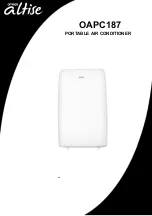
5
Pressure test the system using dry nitrogen and soapy water
to locate leaks. If you wish to use a leak detector, charge the
system to 10 psi using the appropriate refrigerant then use
nitrogen to finish charging the system to working pressure then
apply the detector to suspect areas. If leaks are found, repair
them. After repair, repeat the pressure test. If no leaks exist,
proceed to system evacuation.
System Evacuation
Condensing unit liquid and suction valves are closed. The unit
is shipped with the valve stems closed and caps installed.
REFRIGERANT UNDER PRESSURE!
Failure to follow proper procedures may cause
property damage, personal injury or death.
WARNING
NOTE:
Scroll compressors should never be used to evacuate
or pump down a heat pump or air conditioning system.
NOTICE
THIS UNIT IS SHIPPED WITH A NITROGEN/HELIUM
HOLDING CHARGE ONLY. UNIT MUST BE
EVACUATED AND CHARGED PER INSTALLATION
INSTRUCTIONS WITH REFRIGERANT LISTED ON
SERIAL RATING PLATE.
UNITS SHIPPED WITH A HOLDING CHARGE ARE
INTENDED FOR COMPONENT REPLACEMENT
ONLY ON EXISTING SYSTEMS, AND NOT
INTENDED FOR USE IN NEW SYSTEMS OR NEWLY
CONSTRUCTED HOMES.
NOTICE
NOTICE
UNITS MUST ONLY BE USED AS REPLACEMENT
COMPONENTS FOR PRE-2010 INSTALLED
SYSTEMS.
NOTE:
Holding charge must be removed before brazing.
Prolonged operation at suction pressures less than 20
psig for more than 5 seconds will result in overheating of
the scrolls and permanent damage to the scroll tips, drive
bearings and internal seal.
CAUTION
1. Open service valves before attaching vacuum pump.
2. Connect the vacuum pump with 250 micron capability to
the service valves.
3. Evacuate the system to 250 microns or less using suc-
tion
and
liquid service valves. Using both valves is nec-
essary as some compressors create a mechanical seal
separating the sides of the system.
4. Close pump valve and hold vacuum for 10 minutes. Typi-
cally pressure will rise during this period.
•
If the pressure rises to 1000 microns or less and remains
steady the system is considered leak-free; proceed to
startup.
5000
4500
4000
3500
3000
2500
2000
1500
1000
500
0 1 2 3 4 5 6 7 8 9
10
LEAK(S)
PRESENT
MINUTES
V
ACU
U
M
IN
MI
CR
O
N
S
CONDENSIBLES OR SMALL
LEAK PRESENT
NO LEAKS
NO CONDENSIBLES
•
If pressure rises above 1000 microns but holds steady
below 2000 microns, moisture and/or noncondensibles
may be present or the system may have a small leak.
Return to step 2: If the same result is encountered check
for leaks as previously indicated and repair as necessary
then repeat evacuation.
•
If pressure rises above 2000 microns, a leak is present.
Check for leaks as previously indicated and repair as nec-
essary then repeat evacuation.
Electrical Connections
HIGH VOLTAGE!
Disconnect ALL power before servicing.
Multiple power sources may be present.
Failure to do so may cause property damage,
personal injury or death due to electric shock.
Wiring must conform with NEC or CEC and all
local codes. Undersized wires could cause
poor equipment performance, equipment damage
or fire.
WARNING
To avoid the risk of fire or equipment damage, use
copper conductors.
WARNING
NOTICE
Units with reciprocating compressors and non-bleed TXV’s
require a Hard Start Kit.
The condensing unit rating plate lists pertinent electrical data
necessary for proper electrical service and overcurrent protec-
tion. Wires should be sized to limit voltage drop to 2% (max.)
from the main breaker or fuse panel to the condensing unit.
Consult the NEC, CEC, and all local codes to determine the
correct wire gauge and length.






























